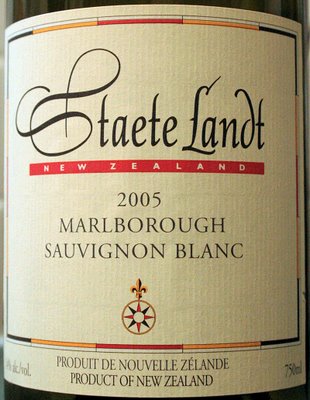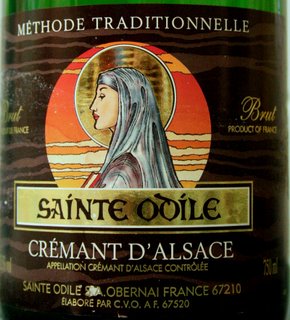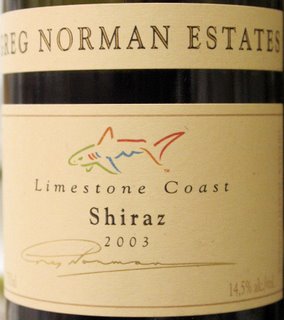 Breaking our usual rule of thumb (well, actually, it's Ed's brother's rule of thumb) that the best sauvignon blancs from New Zealand are those that have "Bay" somewhere in the name, we tried this Staete Landt Marlborough Sauvignon Blanc on the recommendation of staff at the big Willow Heights main liquor store in Calgary. We got grapefruit and floral notes on the nose, and then grapefruit, grapefruit, grapefruit and more grapefruit on the palate. Very refreshing, but very, very citrusy.
Breaking our usual rule of thumb (well, actually, it's Ed's brother's rule of thumb) that the best sauvignon blancs from New Zealand are those that have "Bay" somewhere in the name, we tried this Staete Landt Marlborough Sauvignon Blanc on the recommendation of staff at the big Willow Heights main liquor store in Calgary. We got grapefruit and floral notes on the nose, and then grapefruit, grapefruit, grapefruit and more grapefruit on the palate. Very refreshing, but very, very citrusy.
Monday, August 28, 2006
Staete Landt Marlborough Sauvignon Blanc 2005
 Breaking our usual rule of thumb (well, actually, it's Ed's brother's rule of thumb) that the best sauvignon blancs from New Zealand are those that have "Bay" somewhere in the name, we tried this Staete Landt Marlborough Sauvignon Blanc on the recommendation of staff at the big Willow Heights main liquor store in Calgary. We got grapefruit and floral notes on the nose, and then grapefruit, grapefruit, grapefruit and more grapefruit on the palate. Very refreshing, but very, very citrusy.
Breaking our usual rule of thumb (well, actually, it's Ed's brother's rule of thumb) that the best sauvignon blancs from New Zealand are those that have "Bay" somewhere in the name, we tried this Staete Landt Marlborough Sauvignon Blanc on the recommendation of staff at the big Willow Heights main liquor store in Calgary. We got grapefruit and floral notes on the nose, and then grapefruit, grapefruit, grapefruit and more grapefruit on the palate. Very refreshing, but very, very citrusy.
Barossa Valley Estate Spires Shiraz 2003
 Made in a dryer, less fruity style than some shirazes, this inexpensive Barossa Valley Estate Spires Shiraz ($13.25 in Banff) had the pepperiness typical of the varietal and was certainly worth the money. The label also talked about vanilla flavours, but we didn't really get that. Nonetheless, we'd definitely be willing to buy it again--especially at that price.
Made in a dryer, less fruity style than some shirazes, this inexpensive Barossa Valley Estate Spires Shiraz ($13.25 in Banff) had the pepperiness typical of the varietal and was certainly worth the money. The label also talked about vanilla flavours, but we didn't really get that. Nonetheless, we'd definitely be willing to buy it again--especially at that price.
Sunday, August 06, 2006
Sainte Odile Crémant D'Alsace
 This méthode traditionelle sparkling wine from Alsace lacks the toastiness we like to associate with champagne (at least, with the champagnes we like most), offering instead a generic citrus flavor--very close to lemon. Nevertheless, we deemed Sainte Odile Crémant D'Alsace "very nice" and would certainly recommend it to someone looking for an alternative to champagne. It went very well with our dinner: shrimp in coconut milk.
This méthode traditionelle sparkling wine from Alsace lacks the toastiness we like to associate with champagne (at least, with the champagnes we like most), offering instead a generic citrus flavor--very close to lemon. Nevertheless, we deemed Sainte Odile Crémant D'Alsace "very nice" and would certainly recommend it to someone looking for an alternative to champagne. It went very well with our dinner: shrimp in coconut milk.Our UC Davis 20-Point System-inspired rating: 16.5/20.
Note: Margaret Anne's mom Alice liked this wine very much and wants it noted she though 16.5 was too low.
Greg Norman Estates Limestone Coast Shiraz 2003
 Wine notes at The Willetts on Wine resume after a long hiatus!
Wine notes at The Willetts on Wine resume after a long hiatus!We've got tons of notes to post, but that's been the problem: too many notes, not enough time, and thus we just haven't posted any at all in the mistaken belief we must catch up before we can proceed.
Instead, we're just going to start where we are and try to keep up to date from hence forward, while adding a few older notes as we get the chance.
So, the Greg Norman Estates Limestone Coast Shiraz 2003. Very peppery, but with lots of berry, too, and a good touch of leather (probably from the tannins). It's very nice now but those tannins hold the promise of good aging potential, as well. Our one criticism: we found the nose quite closed--there simply wasn't much there, even after it had been in the glass for a while. Our UC Davis 20-Point System-based score: 16.5/20.
Friday, August 04, 2006
Does this count as terroir?
Apparently, some California wine may owe part of its quality to dead fish.
"What does it take to make a fine California wine? Grapes, water, sunshine, the skilled hand of a master vintner -- and a few thousand dead fish. A few thousand dead chinook salmon, that is, according to new research that shows for the first time that the salmon that die naturally in California's Mokelumne and Calaveras rivers contribute significantly to the growth -- and likely the quality -- of wine grapes raised nearby.
"How? Wild animals eat the salmon carcasses, converting the nutrient-laden fish into fertilizer for the grapevines."
How ya goin' to compete with that, France?
"What does it take to make a fine California wine? Grapes, water, sunshine, the skilled hand of a master vintner -- and a few thousand dead fish. A few thousand dead chinook salmon, that is, according to new research that shows for the first time that the salmon that die naturally in California's Mokelumne and Calaveras rivers contribute significantly to the growth -- and likely the quality -- of wine grapes raised nearby.
"How? Wild animals eat the salmon carcasses, converting the nutrient-laden fish into fertilizer for the grapevines."
How ya goin' to compete with that, France?
Subscribe to:
Comments (Atom)
